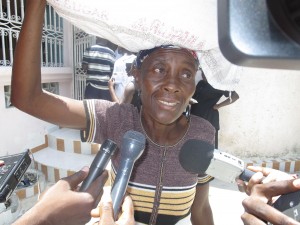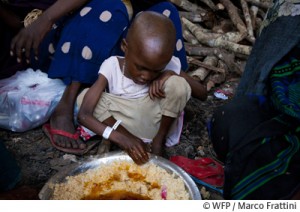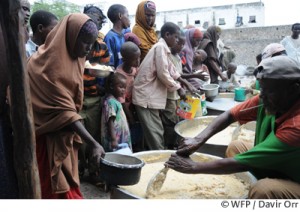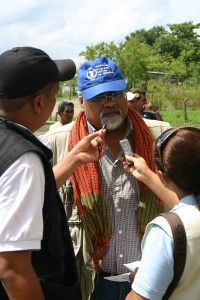By Karuna Kumar
Some flee their homes in the face of war or civil strife; others may be the victims of natural disasters like floods, droughts, earthquakes and hurricanes. They all comprise one billion people across the world who struggle to get food.
“The World Food Programme is the world’s largest humanitarian agency. We are fighting hunger, which is a killer like no other. Hunger kills more people than tuberculosis, AIDS and malaria combined,” says Caroline Hurford, Senior Public Information Officer of the World Food Programme (WFP).
WFP works in collaboration with the Food and Agriculture Organisation (FAO) and the International Fund for Agricultural Development (IFAD). The famine that hit the Horn of Africa last month has already killed tens of thousands of people. According to a recent estimate by FAO, the UN needs $1.6 billion in the next 12 months to provide aid to the region; 12 million people in Djibouti, Ethiopia, Kenya, Somalia and Uganda require emergency assistance. WFP is currently reaching more than 11 million people throughout the Horn.
The need for food aid has become a global problem. The severity of the food crisis calls for prompt action. Hurford relates her efforts in communicating these messages globally and garnering support for the cause worldwide.
The team behind the cause
WFP has around 11,000 staff members based in 80 countries, 90% of whom are from and based in developing countries.
Being 100% voluntarily funded, the organisation largely depends on voluntary contributions from governments and corporate partners and urges individuals to contribute. The United Kingdom is among the top ten countries that give the most aid to the WFP, while Hurford credits the United States for helping to feed Darfur and Sudan.
Communicating during the famine in Africa
Hurford explains:
“We have three public information officers based in Nairobi, who cover the whole of East Africa, and have been watching this drought gather momentum. Our colleagues in Nairobi and Rome have been observing the situation closely and gathering information from our partners based in the field. The public information officers facilitate this flow of information, worldwide, helping us to ramp up interest. We inform the governments of donor countries and explain the severity of the food crisis and urge them to respond.”
Despite WFP’s best efforts to alert the international community, the response has been slow. Having been forced to cut its rations as late as March, due to lack of funds, WFP’s Executive Director, Josette Sheeran, travelled around the region again recently, in a bid to raise international support.
Response of the global community
Hurford says:
“It’s generally only when you get the TV cameras in there, and the dreadful images of skeletal children appear on screen, that the international community wakes up to the cause.”
When governments fail to step up the plate, the Disasters Emergency Committee (DEC, an umbrella for 14 non-governmental organisations) gets UK mainstream media coverage to reach out to the man and woman on the street. The DEC has gathered 20 million pounds so far this way.
Channels of communication – external
“In addition to a public information assistant, I am also supported by a youth outreach consultant. The consultant helps me to tap into schools and colleges and this spreads the word. Schools realise that food is core to development and progress and we are gathering student ambassadors to go and reach out to others,” explains Hurford.
Due to tight budgets, WFP does not spend money on advertising as a means of communication. In recent times, it has begun to harness the power of social media.
“With social media, we have entered a completely different world of communications; Twitter and Facebook are huge new drivers of getting our messages across and LinkedIn helps us to reach out to the corporate world in times of a disaster,” says Hurford.
Staying ahead of the social media curve is what she advocates. The WFP’s public information officers were summoned for a social media training at the headquarters in Rome earlier this year with the aim of furthering WFP’s aims in fighting hunger.
“Now, it would be pretty indefensible to spend money on advertising if we are told that 79% of people trust what their peers say about organisations on Facebook. We want the maximum amount of money raised, to go to the beneficiary rather than invest in advertisements,” Hurford adds.
Internal communications
Pipeline is WFP’s employee magazine which Hurford edited back in 2002 when she joined the organisation.
“It was great fun and I loved working on it. It basically revolved around the stories from staff in the field. It might be something really silly like the longest snake ever found in the Nairobi office and how the program officer tackled the issue and turned out to be a hero. People love to read about their colleagues and what they are upto in the field. They love seeing photographs of people they know and they have worked with”.
WFP Go is the organisation’s intranet and has grown from a primitive tool into a channel that is regularly updated with interesting stories and a highly popular section called ‘Star snapped in action’. Anybody across the organisation can take a picture of their colleagues in action, add a caption and post it under the ‘Star snapped in action’.
Interaction with the head office
The WFP headquarters in Rome has appointed a Head of Internal Communications who has regular meetings with PI’s (Public Information officers) across the world.
“HQ holds a weekly session where a senior member of staff talks about their work and their challenges. I find it a good means of internal communication,” Hurford points out.
She adds, “It is great because we get to interact with our colleagues who may have been on a trip somewhere and this gives them an opportunity to share their experiences with all of us.”
Partnering with NGOs
In communicating with the masses, of essence to an organisation like the World Food Program is an intensive partnership with NGOs. From food to fuel to financial, the NGOs play a crucial role in assisting WFP in delivering critical food and nutrition assistance.
NGOs are described as instrumental in increasing WFP’s global deep field presence and essential in both short and long term responses to hunger. WFP partners with NGOs from 34 countries of which 55% are in Europe. The United States has the highest number of NGOs collaborating with WFP.
One such partner working with WFP for over 20 years is World Vision. In recent times, WFP in collaboration with World vision has implemented a number of school feeding programs, food for work programs and cash for work programs.
Highlighting some of the challenges faced, Walter Middleton, Partnership Leader at World Vision says, “While there have been significant gains working in partnership with WFP, occasionally we do confront a few challenges. One of them is lack of sufficient funding from WFP for development type programs which leads to food pipeline breaks. Also with the short duration of our programs, it is difficult to plan and retain staff.”
He adds, “I would like our partnership to lead to more food for work/cash projects and I would be keen to see World Vision and WFP approach donors jointly for food and funding in the future.”
Partnering with corporates
“While the support of NGOs is fundamental to our approach, I would be very keen to actively continue to partner with corporates like Unilever especially in the area of internal communications. I believe they could share key insights on the practice of internal communication and help us improve our game. Corporates gain a lot of kudos out of partnering with us and it would be helpful if they would share their experience with us. This is what partnership is all about,” says Hurford.
The future
Stationed in a competitive world and yearning for the money to fight hunger, of utmost significance for the WFP is continuing and active support of governments, corporates and the public.
In Hurford’s opinion, it is only through constant engagement with the public that WFP can gain more support. WFP must use traditional and social media alike to advocate and communicate, the plight of those suffering across Africa and Asia.
Hurford says, “We have to remember that in some ways, the humanitarian aid story may only ever be a kind of a sidebar; the main story is always about how many people are dying and who is trying to steal food aid etc. In disasters like a Tsunami, suddenly the efforts we’ve made all through the year get drowned in media scepticism and public scrutiny. This must change.”




